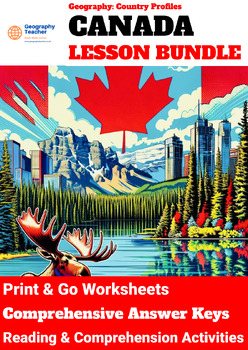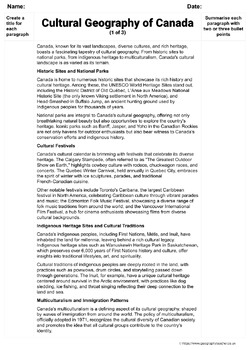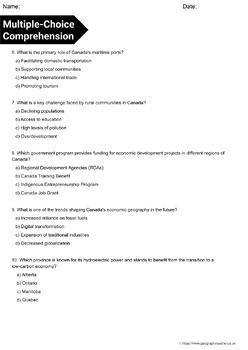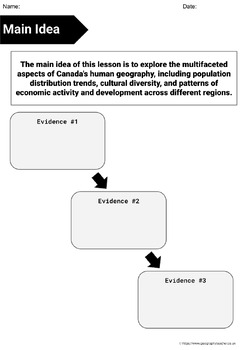Canada Country Study (9-Lesson Geography Bundle)
- Zip
Products in this Bundle (9)
showing 1-5 of 9 products
Bonus
Description
Unmissable 30% discount when you purchase all 9 lessons!
*INCLUDES SPECIAL BONUS TEMPLATE PACK FREE-OF-CHARGE*
This is a great-value lesson bundle of 9 flexible reading comprehension-based lessons based on the 'Canada: Country Study' geography scheme of work.
In the "Canada Country Study" Geography syllabus, students embark on a comprehensive exploration of Canada's geographical, demographic, political, economic, environmental, cultural, and historical landscape. The introductory lesson lays the foundation by acquainting students with Canada's fundamental geography and demographics, encompassing its vast landmass, diverse ecosystems, and varied climate zones.
Subsequent lessons delve deeper into specific aspects, such as the physical geography, human geography, political geography, economic geography, environmental issues, cultural geography, and historical geography of Canada.
Throughout the syllabus, students engage in various activities and discussions to achieve learning objectives tailored to each lesson. For example, they learn to identify major physical features, analyze population distribution patterns, explore cultural diversity, understand the political divisions and government structure, examine economic activities and disparities, address environmental challenges, appreciate cultural heritage, and trace historical events and migrations.
The culminating lesson challenges students to contemplate Canada's future, considering emerging trends such as globalization, technological innovation, and sustainability, and to discuss strategies for addressing future challenges and seizing opportunities for sustainable development.
Through this comprehensive study, students develop a holistic understanding of Canada's past, present, and future, equipping them with valuable insights into its geography, society, economy, environment, and culture.
Student focus:
Lesson 1: Introduction to Canada
- Identify the location of Canada on a map and describe its relative position to other countries and bodies of water.
- Describe the diverse geographical features found within Canada, including its vast landmass, diverse ecosystems, and varied climate zones.
- Analyze population distribution patterns within Canada and discuss factors influencing population density.
Lesson 2: Physical Geography of Canada
- Identify and describe the major physical features of Canada, such as the Canadian Shield, Rocky Mountains, and Great Lakes.
- Explain the significance of major rivers and bodies of water, including the St. Lawrence River, Mackenzie River, and Hudson Bay.
- Analyze climate patterns across different regions of Canada and discuss their impact on human activities and ecosystems.
Lesson 3: Human Geography of Canada
- Analyze population distribution trends within Canada, including urbanization, suburbanization, and rural areas.
- Explore cultural diversity within Canada, including indigenous peoples, linguistic diversity, and immigrant communities.
- Investigate patterns of economic activity and development across different regions of Canada, including industry, agriculture, and services.
Lesson 4: Political Geography of Canada
- Identify the political divisions of Canada, including provinces, territories, and capital cities.
- Explain the structure of the Canadian government, including the federal system, parliamentary democracy, and the roles of the Prime Minister and Governor General.
- Analyze the electoral system and process in Canada, including federal and provincial elections, voting rights, and political parties.
Lesson 5: Economic Geography of Canada
- Identify major industries and economic activities in different regions of Canada, such as natural resources, manufacturing, tourism, and technology.
- Explain the role of transportation networks, including railways, highways, and ports, in facilitating trade and economic development.
- Analyze economic disparities and inequalities within Canada, including regional disparities, indigenous economic development, and urban-rural divides.
Lesson 6: Environmental Issues in Canada
- Identify major environmental issues in Canada, such as air and water pollution, deforestation, and habitat loss.
- Explain the causes and consequences of environmental degradation, including human activities, industrial development, and natural disasters.
- Explore efforts to address environmental challenges in Canada, including conservation initiatives, environmental regulations, and sustainable development strategies.
Lesson 7: Cultural Geography of Canada
- Identify cultural landmarks and symbols associated with Canada, such as historic sites, national parks, and cultural festivals.
- Explore indigenous heritage sites and cultural traditions of First Nations, Métis, and Inuit peoples in Canada.
- Analyze the impact of multiculturalism on Canadian society, including immigration patterns, cultural diversity, and intercultural relations.
Lesson 8: Historical Geography of Canada
- Analyze major events and turning points in Canadian history, including colonial settlements, Confederation, and indigenous treaties.
- Explore patterns of migration and immigration that have shaped the demographic and cultural landscape of Canada, including European colonization, immigration waves, and refugee resettlement.
- Investigate territorial expansion and border changes in Canadian history, including treaties, land claims, and territorial disputes.
Lesson 9: Canada - Future Challenges and Opportunities
- Identify emerging trends and issues shaping the future of Canada, including globalization, demographic shifts, and environmental change.
- Analyze the opportunities and challenges posed by globalization, including economic integration, cultural exchange, and geopolitical dynamics.
- Discuss strategies for addressing future challenges and promoting sustainable development in Canada, including innovation, collaboration, and policy solutions.
----------------------------------------------------------------------------------------------
We offer a FREE product in this format which we encourage you to download, to see if it works for you and your students. This product - The Impact Of Conflict And Displacement On Food Security In Syria- can be downloaded for free here.
----------------------------------------------------------------------------------------------
This resource is perfect for the classroom, distance-learning, homework, exam preparation and home-schooling.
This is a quality, ready-made resource intended for busy teachers, cover teachers, parents and home-schoolers to simply print and go. Each individual resource is packed with a variety of differentiated comprehension activities for students, including 'stretch & challenge tasks' and further recommended classroom, project and homework activities. Each resource also includes a detailed lesson plan, for a 60-minute lesson, based around the reading passage. This provides incredible flexibility for the teacher to transform this resource into a comprehensive, student-centred lesson, which encourages independent and team learning activities. The resource also provides a variety of templates for teachers to carry out Assessment For Learning (AFL) to identify independent student and whole class progress.
Best of all, each individual lesson includes a comprehensive answer key, making teachers' lives far more simple! It also means some students can self-assess or peer-assess their work.
Each Reading Comprehension Learning Resource Includes The Following:
- Reading Passage
- Multiple-Choice Questions
- Plenary: True / False Activities
- Main Idea/Key Details Graphic Organizer
- Who, What, Where, When Graphic Organizer
- Writing Framework For Students
- Standard-Level Comprehension
- Intermediate-Level Comprehension
- Advanced-Level Comprehension
- Stretch & Challenge Questions
- Further Recommended Activities For Teacher And Students
- Detailed 60-Minute Lesson Plan, Based On Article, For Teachers
- Student Summary Worksheets: Lesson Summary, Head Heart Hashtag, Exit Ticket, Progress Pyramid, Planning For Progress
- Student Answer Templates





